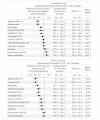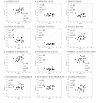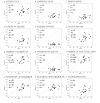Accuracy of 12 Wearable Devices for Estimating Physical Activity Energy Expenditure Using a Metabolic Chamber and the Doubly Labeled Water Method: Validation Study
- PMID: 31376273
- PMCID: PMC6696858
- DOI: 10.2196/13938
Accuracy of 12 Wearable Devices for Estimating Physical Activity Energy Expenditure Using a Metabolic Chamber and the Doubly Labeled Water Method: Validation Study
Abstract
Background: Self-monitoring using certain types of pedometers and accelerometers has been reported to be effective for promoting and maintaining physical activity (PA). However, the validity of estimating the level of PA or PA energy expenditure (PAEE) for general consumers using wearable devices has not been sufficiently established.
Objective: We examined the validity of 12 wearable devices for determining PAEE during 1 standardized day in a metabolic chamber and 15 free-living days using the doubly labeled water (DLW) method.
Methods: A total of 19 healthy adults aged 21 to 50 years (9 men and 10 women) participated in this study. They followed a standardized PA protocol in a metabolic chamber for an entire day while simultaneously wearing 12 wearable devices: 5 devices on the waist, 5 on the wrist, and 2 placed in the pocket. In addition, they spent their daily lives wearing 12 wearable devices under free-living conditions while being subjected to the DLW method for 15 days. The PAEE criterion was calculated by subtracting the basal metabolic rate measured by the metabolic chamber and 0.1×total energy expenditure (TEE) from TEE. The TEE was obtained by the metabolic chamber and DLW methods. The PAEE values of wearable devices were also extracted or calculated from each mobile phone app or website. The Dunnett test and Pearson and Spearman correlation coefficients were used to examine the variables estimated by wearable devices.
Results: On the standardized day, the PAEE estimated using the metabolic chamber (PAEEcha) was 528.8±149.4 kcal/day. The PAEEs of all devices except the TANITA AM-160 (513.8±135.0 kcal/day; P>.05), SUZUKEN Lifecorder EX (519.3±89.3 kcal/day; P>.05), and Panasonic Actimarker (545.9±141.7 kcal/day; P>.05) were significantly different from the PAEEcha. None of the devices was correlated with PAEEcha according to both Pearson (r=-.13 to .37) and Spearman (ρ=-.25 to .46) correlation tests. During the 15 free-living days, the PAEE estimated by DLW (PAEEdlw) was 728.0±162.7 kcal/day. PAEE values of all devices except the Omron Active style Pro (716.2±159.0 kcal/day; P>.05) and Omron CaloriScan (707.5±172.7 kcal/day; P>.05) were significantly underestimated. Only 2 devices, the Omron Active style Pro (r=.46; P=.045) and Panasonic Actimarker (r=.48; P=.04), had significant positive correlations with PAEEdlw according to Pearson tests. In addition, 3 devices, the TANITA AM-160 (ρ=.50; P=.03), Omron CaloriScan (ρ=.48; P=.04), and Omron Active style Pro (ρ=.48; P=.04), could be ranked in PAEEdlw.
Conclusions: Most wearable devices do not provide comparable PAEE estimates when using gold standard methods during 1 standardized day or 15 free-living days. Continuous development and evaluations of these wearable devices are needed for better estimations of PAEE.
Keywords: accelerometry; doubly labeled water; energy expenditure; indirect calorimetry; physical activity.
©Haruka Murakami, Ryoko Kawakami, Satoshi Nakae, Yosuke Yamada, Yoshio Nakata, Kazunori Ohkawara, Hiroyuki Sasai, Kazuko Ishikawa-Takata, Shigeho Tanaka, Motohiko Miyachi. Originally published in JMIR Mhealth and Uhealth (http://mhealth.jmir.org), 02.08.2019.
Conflict of interest statement
Conflicts of Interest: ST reported receiving research funding from Omron Health Care Inc. No other disclosures were reported.
Figures



Similar articles
-
Physical Activity Assessment with the ActiGraph GT3X and Doubly Labeled Water.Med Sci Sports Exerc. 2017 Sep;49(9):1935-1944. doi: 10.1249/MSS.0000000000001299. Med Sci Sports Exerc. 2017. PMID: 28419028 Free PMC article.
-
Evaluation of methods to assess physical activity in free-living conditions.Med Sci Sports Exerc. 2001 Jul;33(7):1233-40. doi: 10.1097/00005768-200107000-00024. Med Sci Sports Exerc. 2001. PMID: 11445774
-
Accuracy of a combined heart rate and motion sensor for assessing energy expenditure in free-living adults during a double-blind crossover caffeine trial using doubly labeled water as the reference method.Eur J Clin Nutr. 2015 Jan;69(1):20-7. doi: 10.1038/ejcn.2014.51. Epub 2014 Apr 2. Eur J Clin Nutr. 2015. PMID: 24690589 Clinical Trial.
-
Usefulness of motion sensors to estimate energy expenditure in children and adults: a narrative review of studies using DLW.Eur J Clin Nutr. 2017 Mar;71(3):331-339. doi: 10.1038/ejcn.2017.2. Epub 2017 Feb 1. Eur J Clin Nutr. 2017. PMID: 28145419 Review.
-
Assessment of Physical Activity in Adults: A Review of Validated Questionnaires From a Nutritionist's Point of View.Eval Health Prof. 2020 Dec;43(4):235-254. doi: 10.1177/0163278720928500. Epub 2020 Jun 22. Eval Health Prof. 2020. PMID: 32567363 Review.
Cited by
-
Questionnaire-based scoring system for screening moderate-to-vigorous physical activity in middle-aged Japanese workers.J Occup Health. 2024 Jan 4;66(1):uiad011. doi: 10.1093/joccuh/uiad011. J Occup Health. 2024. PMID: 38258942 Free PMC article.
-
White Matter Integrity Is Associated With the Amount of Physical Activity in Older Adults With Super-aging.Front Aging Neurosci. 2020 Sep 16;12:549983. doi: 10.3389/fnagi.2020.549983. eCollection 2020. Front Aging Neurosci. 2020. PMID: 33192451 Free PMC article.
-
Person-Generated Health Data in Women's Health: Protocol for a Scoping Review.JMIR Res Protoc. 2021 May 28;10(5):e26110. doi: 10.2196/26110. JMIR Res Protoc. 2021. PMID: 34047708 Free PMC article.
-
Machine learning modeling practices to support the principles of AI and ethics in nutrition research.Nutr Diabetes. 2022 Dec 2;12(1):48. doi: 10.1038/s41387-022-00226-y. Nutr Diabetes. 2022. PMID: 36456550 Free PMC article.
-
Association between Water and Energy Requirements with Physical Activity and Fat-Free Mass in Preschool Children in Japan.Nutrients. 2021 Nov 21;13(11):4169. doi: 10.3390/nu13114169. Nutrients. 2021. PMID: 34836425 Free PMC article.
References
-
- Kyu HH, Bachman VF, Alexander LT, Mumford JE, Afshin A, Estep K, Veerman JL, Delwiche K, Iannarone ML, Moyer ML, Cercy K, Vos T, Murray CJ, Forouzanfar MH. Physical activity and risk of breast cancer, colon cancer, diabetes, ischemic heart disease, and ischemic stroke events: systematic review and dose-response meta-analysis for the global burden of disease study 2013. Br Med J. 2016 Aug 9;354:i3857. doi: 10.1136/bmj.i3857. http://www.bmj.com/cgi/pmidlookup?view=long&pmid=27510511 - DOI - PMC - PubMed
-
- Murakami H, Kawakami R, Nakae S, Nakata Y, Ishikawa-Takata K, Tanaka S, Miyachi M. Accuracy of wearable devices for estimating total energy expenditure: comparison with metabolic chamber and doubly labeled water method. JAMA Intern Med. 2016 Dec 1;176(5):702–3. doi: 10.1001/jamainternmed.2016.0152. - DOI - PubMed

